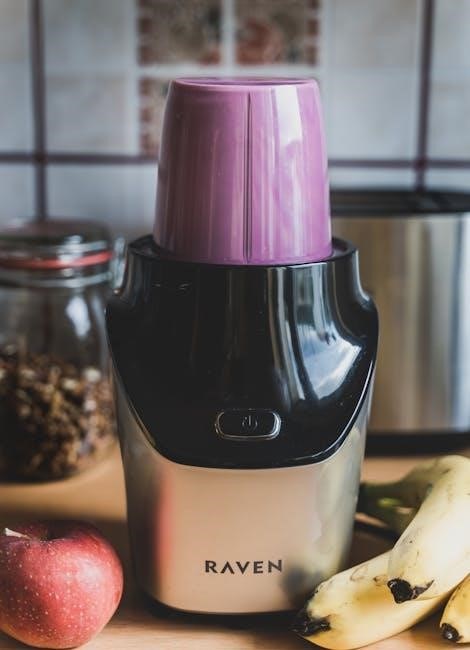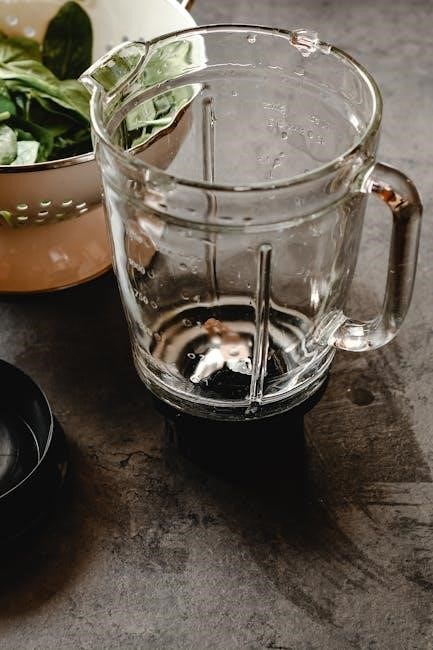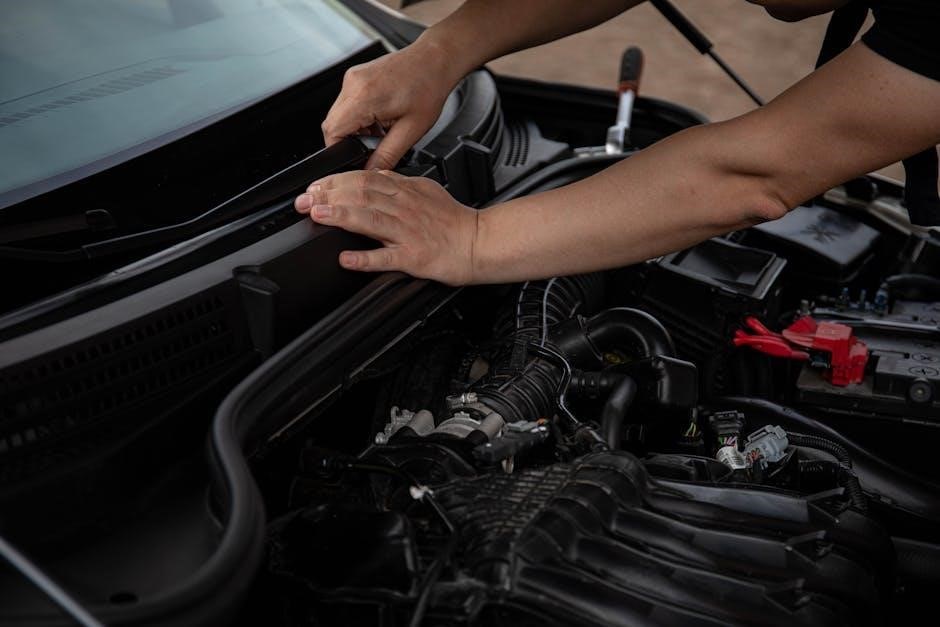Welcome to the Oster Blender Manual! This guide provides essential information to help you understand, operate, and maintain your blender safely and effectively. Reading this manual carefully ensures optimal performance and longevity of your appliance.
1.1 Overview of the Oster Blender
The Oster Blender is a versatile and powerful kitchen appliance designed for efficient blending, mixing, and pureeing. With its robust motor and multiple speed settings, it handles tough ingredients effortlessly. Models like the Osterizer Liquefier Blender and BLSTSE75 Classic Blender offer advanced features such as a dual-purpose lid and durable blade assembly. These blenders are ideal for preparing smoothies, milkshakes, and other culinary creations. Their compact design and user-friendly controls make them a practical addition to any kitchen, ensuring consistent results and easy operation. Whether for casual use or professional-grade blending, Oster Blenders deliver high-quality performance and durability, making them a trusted choice for home cooks and chefs alike.
1.2 Importance of Reading the Manual
Reading the Oster Blender manual is essential for safe and effective use. It provides detailed instructions for assembly, operation, and maintenance, ensuring you understand all features and functions. The manual highlights safety precautions, helping prevent accidents and prolong the blender’s lifespan. It also explains how to troubleshoot common issues, saving time and frustration. By following the guidelines, you can optimize performance, avoid misuse, and maintain warranty coverage. Familiarizing yourself with the manual ensures you get the most out of your blender while preventing potential damage or hazards. It’s a crucial step for both novices and experienced users to ensure longevity and satisfaction.

Installation and Setup
Proper installation ensures safe and efficient blender operation. Place the blender on a stable, flat surface and ensure all parts are unpacked and accounted for. Follow the manual’s setup guide to assemble components correctly, avoiding misuse or damage. Verify all electrical connections and ensure the blender is placed away from water sources. Double-check that all accessories are securely fitted before first use. Proper installation guarantees optimal performance and longevity of your Oster Blender, ensuring a smooth and hassle-free experience.
2.1 Unpacking the Blender
When unpacking your Oster Blender, carefully remove all components from the box to ensure no damage occurs. Inspect each part, including the base, pitcher, lid, blades, and accessories. Check for any visible damage or missing items. Gently lift the blender base and place it on a stable surface. Remove protective packaging materials from the pitcher, blades, and other accessories. Rinse all parts with warm water to eliminate any packaging residue. Organize the accessories in a designated area for easy access. Proper unpacking ensures all components are ready for safe and efficient use. This step is crucial for a smooth setup process.

2.2 Placement and Stability
Place the Oster Blender on a stable, flat surface to ensure safe and efficient operation. Choose a heat-resistant and non-slip surface to prevent movement during use. Ensure the surface is level and away from water sources or hot appliances. Clear the surrounding area of clutter to avoid obstacles. The blender should not be placed near flammable materials or on uneven surfaces, as this could cause instability. For added stability, use a non-slip mat under the base. Proper placement ensures minimal vibration and reduces the risk of accidents. Always position the blender out of reach of children and pets for safety.
2.3 Initial Inspection and Preparation
Before using your Oster Blender, inspect it for any damage or manufacturing defects. Check the power cord, blades, and pitcher for signs of wear. Ensure all components, including the lid, blade assembly, and base, are present. Wash the pitcher, lid, and blades with mild soap and warm water before first use. Rinse thoroughly and dry to prevent water spots. Refer to the manual for specific instructions on assembling the blender correctly. Familiarize yourself with the controls and settings. Proper preparation ensures safety and optimal performance. Always handle the blades with care, as they are sharp and require caution. This step ensures your blender is ready for safe and efficient use.

Safety Guidelines
Always prioritize safety when using your Oster Blender. Keep children away and avoid touching sharp blades. Never blend hot liquids or flammable substances. Ensure the blender is stable and properly assembled before use. Unplug when not in use to prevent accidents. Follow all precautions outlined in the manual to ensure safe and efficient operation. Your safety is paramount, so handle the blender with care and attention.
3.1 General Safety Precautions
Always read and understand the manual before using your Oster Blender. Keep children away from the blender during operation. Never touch the blades or attempt to remove them while the blender is in use. Unplug the blender when not in use or during cleaning. Avoid blending hot liquids or flammable substances, as they may cause splashing or damage. Ensure the lid is securely locked before blending to prevent spills. Never overload the blender jar, as this can lead to uneven blending or motor strain. Always handle the blender with care to ensure safe and efficient operation.
3.2 Electrical Safety Tips
Always plug the Oster Blender into a grounded electrical outlet to prevent shocks. Avoid using damaged cords or loose connections, as they can cause electrical hazards. Never submerge the blender in water or expose it to excessive moisture. Keep the blender away from water sources to prevent accidental splashing. Do not operate the blender near flammable materials or in humid environments. Unplug the blender immediately if you notice unusual smells, sparks, or noises. Ensure the blender is placed on a stable, dry surface to avoid electrical accidents. Always follow the manufacturer’s guidelines for electrical usage to ensure safe operation.
3.3 Handling Blades and Accessories
Always handle the blender blades and accessories with care, as they are sharp and can cause injury. Wear gloves when handling blades to protect your hands. Avoid touching the blades with bare hands, especially when they are wet or soiled. Never use metal utensils to scrape or clean the blades, as this can damage them. When assembling or disassembling accessories, ensure all parts are securely locked in place. Use a soft brush to clean around the blades, avoiding abrasive materials. Store blades and accessories separately to prevent accidental contact. Never leave blades exposed, especially near children. Always follow the manual for proper handling techniques to ensure safety and longevity of the blender.

Operating Instructions
Operating the Oster Blender requires following safety guidelines and understanding the controls. Always use the appropriate speed settings for your ingredients and refer to the manual for detailed instructions.
4.1 Starting the Blender
To start the Oster Blender, ensure it is properly plugged in and placed on a stable surface. Check the power cord for any damage before use. Align and lock the blender jar securely into position—listen for a click to confirm it’s locked. Place the lid on top, ensuring it’s securely fitted to prevent splashing. For ventilation, you can leave the lid slightly ajar but still hold it firmly. Press the power button and begin with a lower speed setting to avoid splashing or overwhelming the motor. Keep the blender away from the edge of the counter to prevent tipping. Do not overload the jar beyond its recommended capacity. If the blender doesn’t start, refer to the manual for troubleshooting steps like resetting the unit.
4.2 Speed Settings and Controls
Your Oster Blender features multiple speed settings designed to handle various blending tasks efficiently. The control panel typically includes options like Low, Medium, and High speeds, allowing you to adjust based on the ingredients. Use the Pulse function for short, powerful bursts to break down tough items like ice or frozen fruit. For delicate ingredients, start with the Low setting to avoid over-processing. The speed controls are usually buttons or a dial, making them easy to navigate. Always choose the right speed for your recipe to ensure optimal results and prevent motor strain. Proper use of these settings extends the blender’s lifespan and performance.
4.3 Blade Assembly and Usage
The Oster Blender comes with durable, stainless steel blades designed for efficient blending. Always ensure the blades are securely locked into place before use. For most blending tasks, the standard blade assembly is sufficient. However, for tougher ingredients like ice or frozen items, consider using the heavy-duty blade option. To assemble, align the blade base with the blender jar and twist clockwise until it clicks. Never touch the blades with bare hands, as they are extremely sharp. After use, detach the blade assembly carefully and rinse with warm water. Regular cleaning prevents residue buildup and maintains blending performance. Always store blades separately when not in use to avoid accidents.
4.4 Using the Dual-Purpose Lid
The Oster Blender features a dual-purpose lid designed for convenience and safety. The lid includes a removable cap for adding ingredients mid-blend and a built-in measuring guide. To use, align the lid with the blender jar and twist until it locks securely. For mess-free pouring, the spout design allows precise control. When adding ingredients, remove the center cap and pour slowly. Always ensure the lid is tightly sealed to prevent leaks. After use, clean the lid and cap thoroughly with warm water. The dual-purpose lid enhances versatility and makes blending more efficient while maintaining safety during operation. Regular cleaning ensures optimal performance and longevity.

Blending Techniques
Explore essential blending techniques to achieve perfect results. Learn how to layer ingredients, handle tough foods, and optimize blends for smoothies, purees, and more efficiently.
5.1 Basic Blending Tips
Start with fresh, high-quality ingredients for optimal flavor. Add liquids first, followed by solids to ensure smooth blending. Chop hard ingredients like ice or frozen items into smaller pieces to prevent strain. Use the pulse function for tough foods to avoid overheating. Avoid overfilling the blender, as this can reduce efficiency and create uneven results. Always secure the lid tightly to prevent leaks; For thicker mixtures, stop and scrape down the sides as needed. Blend in short bursts for delicate items to maintain texture. Clean the blades immediately after use to prevent residue buildup. These tips ensure safe and effective blending.
5.2 Advanced Blending Techniques
For advanced blending, layer ingredients strategically: heavier items like frozen fruits at the bottom and lighter ones on top. Use the timer for precise control over blending duration. Experiment with texture customization by adjusting speed mid-cycle. Incorporate the pulse function to emulsify sauces or dressings without over-blending. For silky smoothies, add a small amount of liquid gradually while blending. When making hummus or thick mixtures, use the tamper to guide ingredients toward the blades. For hot soups, blend in small batches and allow steam to escape. These techniques enhance texture, consistency, and flavor in complex recipes.
5.3 Specific Recipes and Recommendations
Explore these recipes to maximize your Oster Blender’s potential. For a refreshing Tropical Green Smoothie, blend 2 cups spinach, 1 frozen mango, 1 banana, and 1 cup coconut water. Use the pulse function to break down greens evenly. For a Classic Frozen Margarita, combine 2 cups ice, 1 cup tequila, 1 cup limeade, and 1 lime. Blend until smooth, then serve immediately. To make Creamy Hummus, blend 1 cup chickpeas, 1/4 cup tahini, 2 garlic cloves, and 1/4 cup lemon juice. Add 1/4 cup olive oil slowly for a silky texture. These recipes highlight the blender’s versatility and precision blending capabilities.

Maintenance and Cleaning
Regularly clean your Oster Blender after use to prevent residue buildup. Wash removable parts with mild detergent and warm water. Dry thoroughly to avoid moisture damage.
6.1 Cleaning the Blender After Use
Always unplug the blender before cleaning. Wash the pitcher, lid, and blades with warm, soapy water. Avoid using abrasive cleaners or scourers, as they may damage surfaces. Rinse thoroughly and dry with a soft cloth to prevent water spots. For tough residue, blend a mixture of equal parts water and white vinegar for 10-15 seconds. Wipe the motor base with a damp cloth and clean any splatters. Regular cleaning prevents bacterial growth and maintains performance. For convenience, many parts are dishwasher-safe, but check your manual for specific instructions. Cleaning immediately after use ensures easier removal of food particles.
6.2 Regular Maintenance Tips
Regular maintenance ensures your Oster Blender performs optimally. Lubricate the gear system periodically to reduce friction and wear. Check and replace worn-out parts like the gasket or blades to prevent leaks or poor performance. Inspect the power cord for damage and ensure all connections are secure. Avoid overloading the blender, as this can strain the motor. Use a soft brush to remove food particles from the blades and crevices. Store the blender in a dry place to prevent rust. Regular maintenance extends the lifespan of your blender and ensures consistent results. Schedule these checks every 1-2 months for best performance.
6.3 Storage and Organization
Proper storage and organization are essential for maintaining your Oster Blender. Store the blender in a dry, cool place to prevent rust and moisture buildup. After cleaning, detach the jar and blades for individual storage. Use the original packaging or a protective cover to shield the blender from dust. Organize accessories like lids, blades, and spatulas in labeled containers for easy access. Avoid stacking heavy items on top of the blender to prevent damage. Regularly check stored parts for signs of wear or damage. Proper storage ensures longevity and keeps your blender ready for use whenever needed.

Troubleshooting Common Issues
Troubleshooting common issues with your Oster Blender ensures optimal performance. Identify problems like jammed blades or uneven mixing, then refer to the manual for solutions. Regular maintenance can prevent many issues and ensure smooth operation.

7.1 Identifying Common Problems
Common issues with your Oster Blender may include jammed blades, uneven mixing, or leakage. Other problems could involve noise or vibration, or the blender not turning on. Identify these issues by observing performance. If blades stop moving, check for overloading or improper assembly; For uneven mixing, ensure the lid is secure and ingredients are balanced. Leakage often results from a loose or damaged seal. Excessive noise may indicate worn parts or misalignment. If the blender doesn’t start, verify power supply and cord connection. Recognizing these signs early helps prevent damage and ensures efficient operation. Always refer to the manual for specific guidance.
7.2 Resetting the Blender
To reset your Oster Blender, start by unplugging it from the power source. This ensures safety and allows the motor to cool down if it has overheated. Next, check for any blockages or obstructions in the blades or jar. If the blender has an overload protection feature, it may automatically shut off, requiring a 30-minute cooldown period. After addressing any issues, plug in the blender and ensure the jar is properly aligned and secured. Press the reset button, if available, or simply turn it back on. Always refer to the manual for model-specific reset instructions to restore function and prevent further issues.
7.3 Addressing Noise or Vibration
If your Oster Blender is producing excessive noise or vibration, ensure it is placed on a stable, flat surface. Check that the jar and lid are properly aligned and securely locked. Overloaded pitchers or imbalanced blade assemblies can cause vibration; ensure the contents are evenly distributed and within the recommended capacity. Regularly clean the blade assembly to remove debris that may cause imbalance. Lubricate moving parts if suggested by the manual. If noise persists, inspect for worn or loose components and tighten them. For severe issues, consult the troubleshooting section or contact customer support for assistance.

Warranty and Support
This section covers warranty details, support options, and resources to help you maintain and troubleshoot your Oster Blender effectively for registered products with dedicated customer service.
8.1 Understanding the Warranty
The Oster Blender comes with a limited warranty that varies by model and region. Typically, it covers defects in materials and workmanship for a specified period from the purchase date. The warranty applies to the original purchaser and may require registration. It does not cover damage caused by misuse, improper cleaning, or normal wear and tear. For warranty claims, retain your purchase receipt and contact Oster’s customer service. Understanding your warranty ensures you can address issues promptly and enjoy hassle-free blending experiences.
8.2 Contacting Customer Support
Oster’s customer support team is available to assist with any questions or concerns about your blender. You can contact them via phone, email, or through the official Oster website. Visit the “Contact Us” page on their website to find the appropriate contact method for your region. When reaching out, have your blender’s model number and purchase details ready to expedite the process. Oster’s support team is committed to providing timely and effective solutions to ensure your blending experience remains seamless. For troubleshooting or warranty-related inquiries, their knowledgeable representatives are ready to help. Contact them during business hours for the best assistance.
8.3 Online Resources and Manuals
Oster provides comprehensive online resources to support your blender usage. Visit their official website to access digital versions of the manual, troubleshooting guides, and FAQs. These resources are designed to help you maximize your blender’s performance and address any issues quickly. Additionally, Oster offers downloadable guides for specific models, ensuring you have tailored information at your fingertips. For visual learners, video tutorials and demonstrations are available to guide you through advanced features and maintenance. Regularly check the Oster website for updates, new recipes, and tips to enhance your blending experience. These online tools are free and easily accessible, offering ongoing support for your Oster blender.
This manual provides a comprehensive guide to understanding and optimizing your Oster blender. By following the instructions and tips, you’ll master blending techniques and enjoy lasting performance.
9.1 Summary of Key Points
This manual has provided a detailed guide to using your Oster blender effectively. From installation and safety tips to operating instructions and maintenance, each section ensures optimal performance. Key points include proper placement, handling blades safely, using speed settings wisely, and regular cleaning. Blending techniques, troubleshooting, and warranty information are also covered to enhance your experience. By following these guidelines, you’ll extend the blender’s lifespan and achieve consistent results. Always refer back to this manual for clarity and to resolve any issues promptly. Happy blending!
9.2 Final Tips for Optimal Use
For optimal use of your Oster blender, experiment with new recipes to explore its full potential. Utilize the pulse function for tough ingredients and ensure the lid is securely locked to avoid spills. Regularly check and replace worn parts to maintain performance. Refer to the manual for troubleshooting guides and maintenance tips. Always clean the blender immediately after use to prevent residue buildup. By following these tips, you’ll extend the lifespan of your blender and achieve consistent, professional-grade results. Happy blending!




